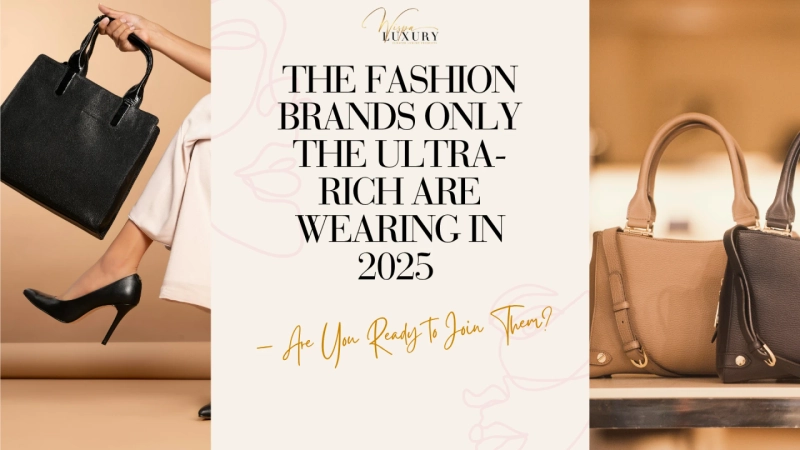The ultra-rich have always possessed an innate understanding of true luxury, and in 2025, their fashion choices reveal a fascinating world of exclusivity that goes far beyond price tags. These discerning individuals gravitate toward fashion brands that represent more than just clothing—they seek pieces that embody heritage, craftsmanship, and the kind of rarity that money alone cannot guarantee. What we're witnessing this year is a deliberate shift toward brands that offer not just products, but membership into an exclusive club where scarcity drives desirability.
The most coveted fashion brands among the ultra-wealthy combine centuries-old artisanal traditions with innovative design approaches, creating pieces that serve as both personal statements and investment opportunities. These brands have mastered the art of exclusivity through limited production, no-discount policies, and waiting lists that can span years, transforming their products into symbols of ultimate prestige and cultural capital.
What Makes a Fashion Brand Coveted by the Ultra-Rich?
Exclusivity remains the cornerstone of ultra-luxury appeal, but it's the combination of craftsmanship, heritage, and scarcity that truly sets these fashion brands apart from mainstream luxury offerings. The ultra-rich understand that true luxury lies in owning pieces that cannot be easily acquired, regardless of budget—items that require patience, connections, or simply the right timing to obtain.
Brand legacy plays an equally crucial role, as artisanal quality and generational expertise create an authenticity that cannot be manufactured overnight. The most prestigious fashion brands maintain strict no-discount policies and deliberately limit availability, understanding that desire increases exponentially when supply remains controlled and exclusive access becomes a privilege rather than a given transaction.
The Top Fashion Brands Dominating the Ultra-Rich Market in 2025
The hierarchy of ultra-luxury fashion brands in 2025 is dominated by houses that have perfected the balance between tradition and innovation:
Louis Vuitton continues to reign supreme with its unparalleled heritage in leather craftsmanship and iconic monogram pieces that have become synonymous with luxury travel and sophistication. The brand's limited edition collections and collaborations with contemporary artists ensure its relevance among younger ultra-high-net-worth individuals.
Hermès stands as the ultimate symbol of exclusivity, with its legendary Birkin bag waiting lists and artisanal approach to leather goods that can take craftspeople years to master. Chanel maintains its timeless appeal through classic designs that appreciate in value, with the brand valued at $13.2 billion due to its exclusivity, value-based marketing, and legacy that creates loyal following among fashion-conscious consumers. Dior ‘s haute couture legacy and meticulous attention to detail continue to attract the most discerning clientele.
Source: AYRA - The Top 20 Luxury Fashion Brands in the World 2025 Gucci's iconic branding and trend influence, alongside prestigious names like Prada, Saint Laurent, and Loewe, round out the elite circle of fashion brands that define ultra-rich wardrobes.
Iconic Pieces That Define Ultra-Rich Status
Certain signature items have transcended fashion to become symbols of membership in the world's most exclusive circles. Hermès Birkin and Kelly bags represent the pinnacle of handbag luxury, often appreciating in value faster than traditional investments and requiring years-long relationships with the brand to acquire. Louis Vuitton's limited edition collections create similar exclusivity, with pieces that often sell out within hours of release to the brand's most valued clients.
Chanel's classic flap bags and haute couture pieces maintain their status as timeless investments, while luxury timepieces from houses like Rolex and Patek Philippe serve dual purposes as both fashion statements and serious financial assets. Owning these pieces signals more than wealth—it demonstrates insider knowledge, patience, and the social connections necessary to access the most coveted items in the luxury market.
The Role of Innovation and Heritage in Sustaining Luxury Brand Status
The most successful ultra-luxury fashion brands have mastered the delicate balance between honoring their heritage and embracing innovation to remain culturally relevant. Creative directors at these houses understand that their clientele values both the security of tradition and the excitement of creative evolution, leading to collaborations and limited collections that breathe new life into established luxury codes.
Bespoke services and personalization options have become increasingly important, allowing ultra-rich consumers to create truly unique pieces that reflect their individual tastes while maintaining the brand's prestigious associations. This combination of exclusivity, heritage, and personalization ensures that these fashion brands continue to hold their coveted positions in the luxury hierarchy.
How Ultra-Rich Consumers Shop Fashion Brands Differently
The shopping experience for ultra-high-net-worth individuals extends far beyond traditional retail, emphasizing privacy, personalization, and exclusive access that regular consumers never encounter. Private sales, trunk shows, and invitation-only previews allow these discerning clients to view and purchase pieces before they reach public availability, maintaining their advantage in acquiring the most desirable items.
Personalized service has evolved to include dedicated relationship managers, private styling consultations, and even custom creation services that transform shopping from a transaction into a carefully curated experience. Additionally, sustainability and ethical sourcing have become increasingly important factors, with many ultra-rich consumers preferring brands that demonstrate environmental responsibility and fair labor practices alongside their luxury credentials.
Why These Fashion Brands Are More Than Just Status Symbols
Beyond their obvious prestige value, the most coveted fashion brands have proven themselves as legitimate investment opportunities with strong resale markets that often exceed traditional financial instruments. Pieces from houses like Hermès, Chanel, and vintage luxury items regularly appreciate, making them both beautiful possessions and smart financial decisions for the ultra-wealthy.
The emotional and cultural significance attached to owning pieces from these legendary fashion brands creates deep, lasting connections that transcend typical consumer relationships. These brands foster multi-generational loyalty, with families passing down both individual pieces and brand relationships, creating a legacy that extends far beyond the original purchase and establishing ongoing cultural capital within elite social circles.
Frequently Asked Questions
What makes these fashion brands so exclusive for the ultra-rich? They combine heritage craftsmanship, limited availability, and no-discount policies that create genuine scarcity regardless of budget.
How do ultra-rich consumers access these exclusive fashion brands? Through private sales, personal relationships with brand representatives, and invitation-only events that bypass public retail channels.
Are these fashion brands good investments? Many pieces from top luxury houses appreciate in value, with some Hermès bags and vintage Chanel pieces outperforming traditional investments.
What's the difference between regular luxury and ultra-luxury fashion brands? Ultra-luxury brands maintain strict exclusivity through limited production, waiting lists, and personalized service that creates genuine scarcity.
How do these brands maintain their status among the ultra-wealthy? By balancing heritage with innovation, maintaining exclusivity, and providing experiences that cannot be replicated at any price point.
Conclusion
The fashion brands that dominate ultra-rich wardrobes in 2025 represent a masterful combination of exclusivity, heritage, and innovation that creates desire far beyond their already substantial price points. These houses have understood that true luxury lies not just in high-quality products, but in the careful cultivation of scarcity, tradition, and personalized experiences that money alone cannot guarantee access to.
What sets these fashion brands apart is their ability to create cultural capital alongside beautiful clothing and accessories, offering their ultra-wealthy clientele membership in an exclusive world where patience, connections, and discernment matter more than purchasing power. As we move through 2025, these brands continue to evolve while maintaining the fundamental principles that have made them the ultimate symbols of luxury and exclusivity among those who can afford anything but choose only the most extraordinary.
Ready to explore the world of ultra-luxury fashion? Discover exceptional pieces and unique finds from the most coveted fashion brands at Wispa.luxury —the best online website to shop luxury brands. From heritage houses to exclusive collections, elevate your wardrobe with authentic luxury pieces that define true sophistication and style. Experience affordable luxury options alongside investment-worthy pieces that speak to your discerning taste.


